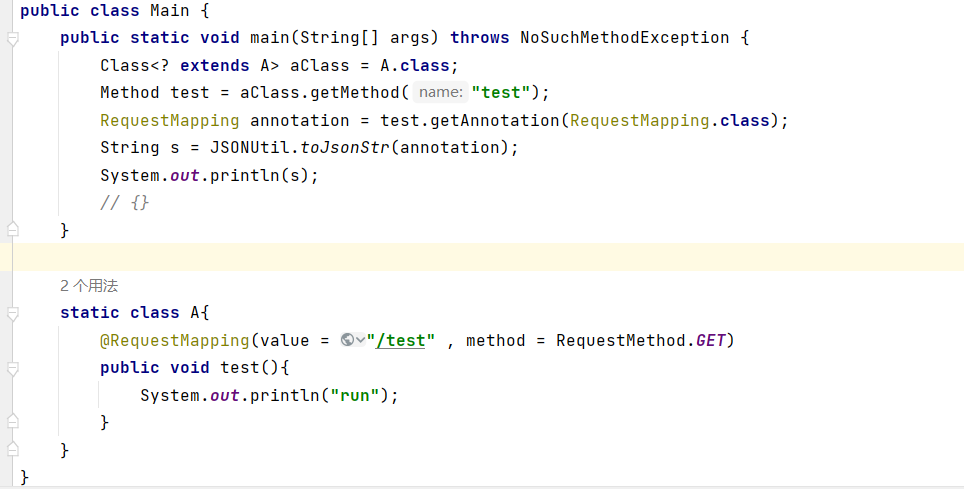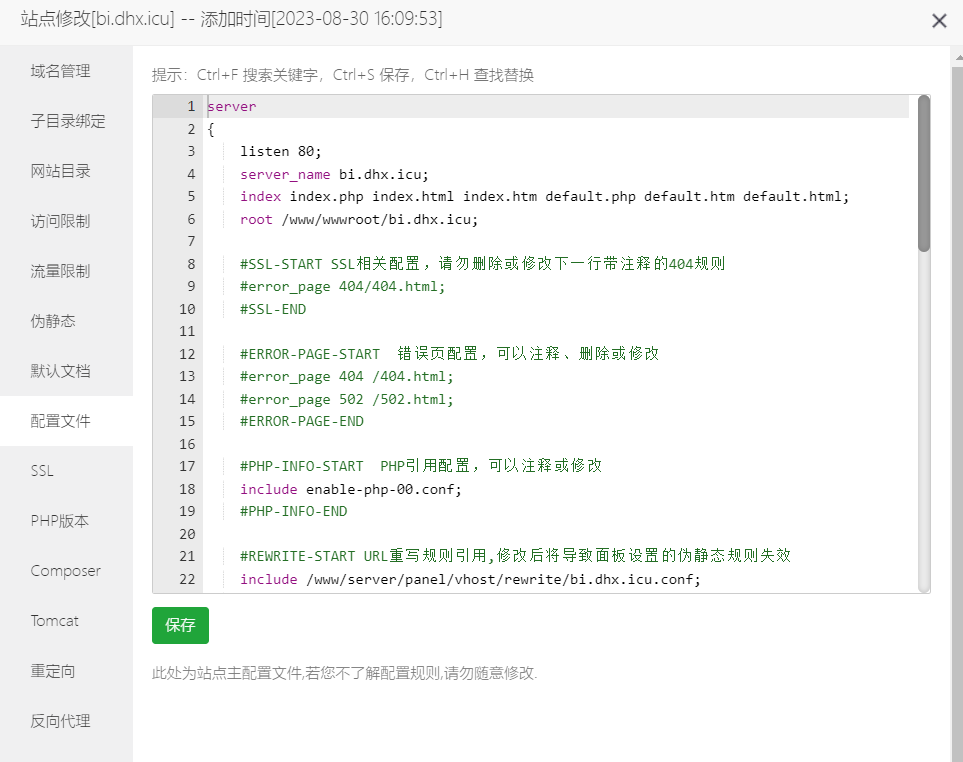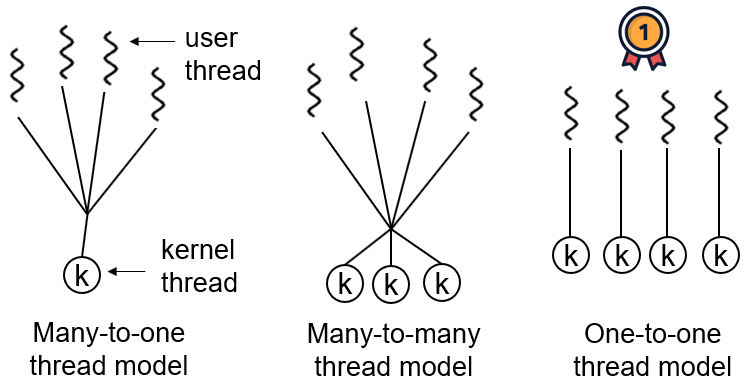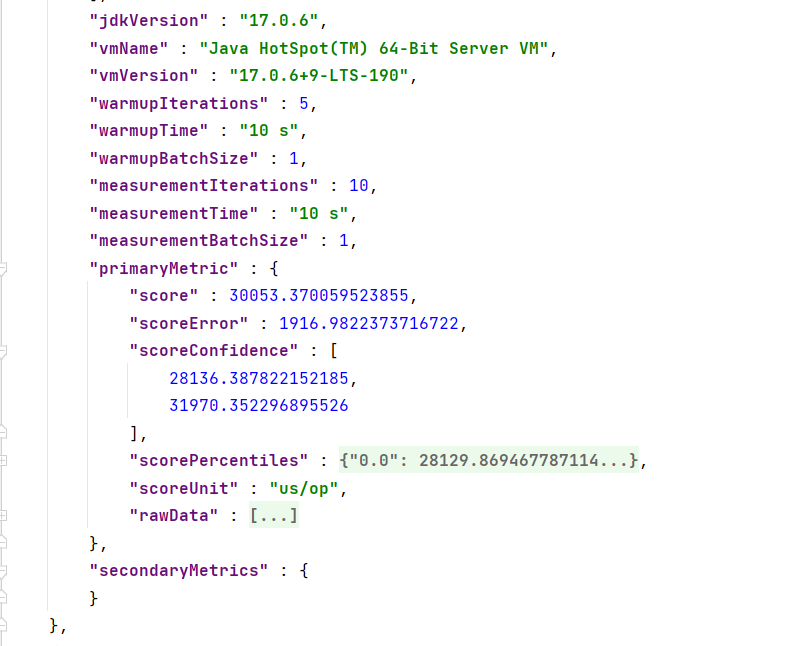日志级别
TRACE, DEBUG, INFO, WARN, ERROR, FATAL, OFF
AOP+注解
下面给出一个简单的日志示例
AOP面向切面编程包含三步
- 定义切面
- 切面逻辑
- 织入 (spring帮助我们完成)
首先定义SysLog注解如下
1
2
3
4
5
6
| @Target({ElementType.METHOD})
@Retention(RetentionPolicy.RUNTIME)
@Documented
public @interface SysLog {
String value() default "";
}
|
接着我们定义AOP类
1
2
3
4
5
6
7
8
9
10
11
12
13
14
15
16
17
18
19
20
21
22
23
24
25
26
27
28
29
30
| @Aspect
@Component
@Slf4j
public class SysLogAOP {
@Pointcut("@annotation(com.danxiaocampus.api.common.annotation.SysLog)")
public void logPointcut(){
}
@Around(value= "logPointcut()")
public Object run(ProceedingJoinPoint joinPoint) throws Throwable {
Object[] args = joinPoint.getArgs();
Signature signature = joinPoint.getSignature();
Method method = ( (MethodSignature)signature ).getMethod();
Method realMethod = joinPoint.getTarget().getClass().getDeclaredMethod(signature.getName(), method.getParameterTypes());
Annotation[] annotations = realMethod.getAnnotations();
SysLog sysLog = realMethod.getAnnotation(SysLog.class);
if(sysLog != null){
String now = new SimpleDateFormat("yy-MM-dd HH:mm:ss").format(new Date());
log.info(now+" 执行内容: {}",sysLog.value());
return joinPoint.proceed(args);
} else {
return joinPoint.proceed(args);
}
}
}
|
接着我们在一个登录方法上面加上注解

启动项目, 访问接口 , 查看控制台

这里只是简单的实现AOP的代码逻辑 , 后面再详细的添加日志的各项参数
根据日志级别分文件存放并打包
首先更改项目配置文件 , 设置配置文件为我们下面需要进行的配置文件
1
2
| logging:
config: classpath:logback-spring.xml
|
接着在resources目录中创建logback-spring.xml 文件, 然后复制下面的内容
-
这里文件名随便起名, 不过需要跟配置文件中的文件名对应 , 文件名需要浅显易懂
-
默认设置控制台输出的日志级别为info
-
logs这里使用的为相对路径 , 目录默认与项目目录同级别
1
2
3
4
5
6
7
8
9
10
11
12
13
14
15
16
17
18
19
20
21
22
23
24
25
26
27
28
29
30
31
32
33
34
35
36
37
38
39
40
41
42
43
44
45
46
47
48
49
50
51
52
53
54
55
56
57
58
59
60
61
62
63
64
65
66
67
68
69
70
71
72
73
74
75
76
77
78
79
80
81
82
83
84
85
86
87
88
89
90
91
92
93
94
95
96
97
98
99
100
101
102
103
104
105
106
107
108
109
110
111
112
113
114
115
116
117
118
119
120
| <configuration debug="false" scan="true" scanPeriod="10 seconds">
<contextName>logback</contextName>
<property name="path" value="../logs"/>
<property name="maxFileSize" value="800MB"/>
<property name="maxHistory" value="30"/>
<appender name="console" class="ch.qos.logback.core.ConsoleAppender">
<filter class="ch.qos.logback.classic.filter.ThresholdFilter">
<level>info</level>
</filter>
<encoder>
<pattern>%date [%level] [%thread] %logger{36} [%file : %line] %msg%n
</pattern>
</encoder>
</appender>
<appender name="debug_file" class="ch.qos.logback.core.rolling.RollingFileAppender">
<file>${path}/logback_debug.log</file>
<rollingPolicy class="ch.qos.logback.core.rolling.TimeBasedRollingPolicy">
<fileNamePattern>${path}/logback_debug.log.%d{yyyy-MM-dd}-%i.zip</fileNamePattern>
<maxHistory>${maxHistory}</maxHistory>
<timeBasedFileNamingAndTriggeringPolicy
class="ch.qos.logback.core.rolling.SizeAndTimeBasedFNATP">
<maxFileSize>${maxFileSize}</maxFileSize>
</timeBasedFileNamingAndTriggeringPolicy>
</rollingPolicy>
<encoder>
<pattern>%date [%level] [%thread] %logger{36} [%file : %line] %msg%n
</pattern>
</encoder>
<filter class="ch.qos.logback.classic.filter.LevelFilter">
<level>DEBUG</level>
<onMatch>ACCEPT</onMatch>
<onMismatch>DENY</onMismatch>
</filter>
</appender>
<appender name="info_file" class="ch.qos.logback.core.rolling.RollingFileAppender">
<file>${path}/logback_info.log</file>
<rollingPolicy class="ch.qos.logback.core.rolling.TimeBasedRollingPolicy">
<fileNamePattern>${path}/logback_info.log.%d{yyyy-MM-dd}-%i.zip</fileNamePattern>
<maxHistory>${maxHistory}</maxHistory>
<timeBasedFileNamingAndTriggeringPolicy
class="ch.qos.logback.core.rolling.SizeAndTimeBasedFNATP">
<maxFileSize>${maxFileSize}</maxFileSize>
</timeBasedFileNamingAndTriggeringPolicy>
</rollingPolicy>
<encoder>
<pattern>%date [%level] [%thread] %logger{36} [%file : %line] %msg%n
</pattern>
</encoder>
<filter class="ch.qos.logback.classic.filter.LevelFilter">
<level>INFO</level>
<onMatch>ACCEPT</onMatch>
<onMismatch>DENY</onMismatch>
</filter>
</appender>
<appender name="warn_file" class="ch.qos.logback.core.rolling.RollingFileAppender">
<file>${path}/logback_warn.log</file>
<rollingPolicy class="ch.qos.logback.core.rolling.TimeBasedRollingPolicy">
<fileNamePattern>${path}/logback_warn.log.%d{yyyy-MM-dd}-%i.zip</fileNamePattern>
<maxHistory>${maxHistory}</maxHistory>
<timeBasedFileNamingAndTriggeringPolicy
class="ch.qos.logback.core.rolling.SizeAndTimeBasedFNATP">
<maxFileSize>${maxFileSize}</maxFileSize>
</timeBasedFileNamingAndTriggeringPolicy>
</rollingPolicy>
<encoder>
<pattern>%date [%level] [%thread] %logger{36} [%file : %line] %msg%n
</pattern>
</encoder>
<filter class="ch.qos.logback.classic.filter.LevelFilter">
<level>WARN</level>
<onMatch>ACCEPT</onMatch>
<onMismatch>DENY</onMismatch>
</filter>
</appender>
<appender name="error_file" class="ch.qos.logback.core.rolling.RollingFileAppender">
<file>${path}/logback_error.log</file>
<rollingPolicy class="ch.qos.logback.core.rolling.TimeBasedRollingPolicy">
<fileNamePattern>${path}/logback_error.log.%d{yyyy-MM-dd}-%i.zip</fileNamePattern>
<maxHistory>${maxHistory}</maxHistory>
<timeBasedFileNamingAndTriggeringPolicy
class="ch.qos.logback.core.rolling.SizeAndTimeBasedFNATP">
<maxFileSize>${maxFileSize}</maxFileSize>
</timeBasedFileNamingAndTriggeringPolicy>
</rollingPolicy>
<encoder>
<pattern>%date [%level] [%thread] %logger{36} [%file : %line] %msg%n
</pattern>
</encoder>
<filter class="ch.qos.logback.classic.filter.LevelFilter">
<level>ERROR</level>
<onMatch>ACCEPT</onMatch>
<onMismatch>DENY</onMismatch>
</filter>
</appender>
<root level="info">
<appender-ref ref="console"/>
</root>
<logger name="com.danxiaocampus.api" level="DEBUG">
<appender-ref ref="debug_file"/>
<appender-ref ref="info_file"/>
<appender-ref ref="warn_file"/>
<appender-ref ref="error_file"/>
</logger>
</configuration>
|
日志各项数据
LogParam
1
2
3
4
5
6
7
8
9
10
11
12
13
14
15
16
17
18
19
20
21
22
23
24
25
26
| @Data
static class LogParam {
private Long userId;
private Map<String,Object> methodParams;
private String url;
private String httpMethod;
LogParam(int capacity){
methodParams =new HashMap<>(capacity);
}
}
|
统计接口信息
记录接口信息的时候遇到了一个问题 , 就是一般我们定义接口都会使用多个注解 @XXXMapping() , 这里的处理思路是通过反射去获取被@SysLog注解修饰的方法 ,
然后通过反射去获取方法上面的注解, 然后获取注解的类型 , 进行遍历
这里切忌直接使用target对象的getClass() 方法, 虽然我这里通过自己封装的AopUtile的工具类进行操作 , 返回真实的对象 , 但是在debug的过程中发现并非如此 ,
1
2
| Annotation target = (Annotation)AopUtil.getTarget(annotation);
Class<? extends Annotation> aClass = target.annotationType();
|
这里AopUtil判断的方式是通过spring提供的AopUtils工具类的isAopProxy(Object obj)方法 , 但是在实际过程中发现此方法并不能如愿,
因此不能直接使用getClass()方法
如果getTarget()并没有返回真实的对象, 仍然是代理对象, 那么我们调用getClass()方法得到的结果就是代理对象的类 , 这里为com.sun.Proxy ,
正确的做法是使用annotationType()方法来获取注解的类型。

完整的getTarget()方法
1
2
3
4
5
6
7
8
9
10
11
12
13
| public static Object getTarget(Object proxy) throws Exception {
if (!AopUtils.isAopProxy(proxy)) {
return proxy;
}
if (AopUtils.isJdkDynamicProxy(proxy)) {
return getJdkDynamicProxyTargetObject(proxy);
} else if(AopUtils.isCglibProxy(proxy)){
return getCglibProxyTargetObject(proxy);
}
return proxy;
}
|
那么接着来分析 @XXXMapping
对于一般的@RequestMapping , 修饰该注解的注解为@Mapping
1
2
3
4
5
6
7
8
9
10
11
12
13
14
15
16
17
18
19
20
21
22
23
24
| @Target({ElementType.TYPE, ElementType.METHOD})
@Retention(RetentionPolicy.RUNTIME)
@Documented
@Mapping
public @interface RequestMapping {
String name() default "";
@AliasFor("path")
String[] value() default {};
@AliasFor("value")
String[] path() default {};
RequestMethod[] method() default {};
String[] params() default {};
String[] headers() default {};
String[] consumes() default {};
String[] produces() default {};
}
|
但是对于@GetMapping这种 , 他这里套了一个@AliasFor
@AliasFor
1
2
3
4
5
6
7
8
9
10
11
12
13
14
15
16
17
18
19
20
21
22
23
24
25
26
27
28
29
30
31
32
33
34
35
36
37
38
39
40
41
42
43
44
45
46
47
48
49
50
| @Target(ElementType.METHOD)
@Retention(RetentionPolicy.RUNTIME)
@Documented
@RequestMapping(method = RequestMethod.GET)
public @interface GetMapping {
@AliasFor(annotation = RequestMapping.class)
String name() default "";
@AliasFor(annotation = RequestMapping.class)
String[] value() default {};
@AliasFor(annotation = RequestMapping.class)
String[] path() default {};
@AliasFor(annotation = RequestMapping.class)
String[] params() default {};
@AliasFor(annotation = RequestMapping.class)
String[] headers() default {};
@AliasFor(annotation = RequestMapping.class)
String[] consumes() default {};
@AliasFor(annotation = RequestMapping.class)
String[] produces() default {};
}
|
简单来说 , @AliasFor可以定义一个注解中的两个属性互为别名。
- 用到注解 属性上,表示两个属性互相为别名,互相为别名的属性值必须相同,若设置成不同,则会报错
- 注解是可以继承的,但是注解是不能继承父注解的属性的 , 也就是说 , 我在类扫描的时候 , 拿到的注解的属性值依然是父注解的属性值 , 而不是你定义的注解的属性值 , 所以此时可以在子注解对应的属性上加上
@AliasFor
那么结合上面的源码来对比 , 这里的@AliasFor(annotation = RequestMapping.class) 相当于定义了父注解为@RequestMapping
这里我们为了区分@ReqeustMapping 以及@GetMapping 直接通过反射获取对象上面的注解 , 然后进行判断即可 ,
这里我们通过注解上面的@RequestMapping 只能判断当前的注解不是@RequestMapping , 不能判断这个注解到底是@GetMaping 还是@PostMapping ,
即便我们可以通过annotationType() 方法直接注解的类型, 但是却无法在代码中进行相应类型的强制转换 , 因为你不能写出
GetMapping getMapping = (aClass)annotation; 这样的代码 , 那么目前考虑到两种办法来进行操作
- 通过解析注解的
toString()方法的结果 , 即能获取到数据(value等) , 也能获取到注解的类型 , 缺点是操作起来比较复杂
- 使用if-else 挨个判断 , 这里注解不多, 只需要几个if-else即可得出我们想要的结果, 缺点是代码看起来比较冗余 , 并且不方便后续维护
或许你会感到奇怪 , 既然这里已经使用反射了, 为什么不直接通过反射来获取到对象的值呢?
我们通过aClass对象上面的注解 , 可以确定当前接口使用的注解是什么 GetMapping (不唯一) 或者是ReqeustMapping

通过aClass获取不到注解的Field

方便起见 , 这里暂时使用if-else实现代码逻辑
为了避免日志妨碍正常的业务逻辑 , 获取annotation的地方使用try-catch包裹
1
2
3
4
5
6
7
8
9
10
11
12
13
14
15
16
17
18
19
20
21
22
23
24
25
26
27
28
29
30
31
32
33
34
35
36
37
38
39
40
| for (Annotation annotation : annotations) {
Annotation target = (Annotation)AopUtil.getTarget(annotation);
Class<? extends Annotation> aClass = target.annotationType();
if(aClass.getAnnotation(Mapping.class)!=null){
RequestMapping requestMapping = (RequestMapping)annotation;
RequestMethod[] httpMethod = requestMapping.method();
String[] value = requestMapping.value();
this.httpMethod=httpMethod[0].toString();
this.url=value[0];
}else if(aClass.getAnnotation(RequestMapping.class)!=null){
try{
if(annotation instanceof GetMapping){
GetMapping getMapping= (GetMapping)annotation;
String[] value = getMapping.value();
this.httpMethod=HttpMethod.GET.toString();
this.url=value[0];
}else if(annotation instanceof PostMapping){
PostMapping getMapping= (PostMapping)annotation;
String[] value = getMapping.value();
this.httpMethod=HttpMethod.POST.toString();
this.url=value[0];
}else if(annotation instanceof DeleteMapping){
DeleteMapping getMapping= (DeleteMapping)annotation;
String[] value = getMapping.value();
this.httpMethod=HttpMethod.DELETE.toString();
this.url=value[0];
}else if(annotation instanceof PutMapping){
PutMapping getMapping= (PutMapping)annotation;
String[] value = getMapping.value();
this.httpMethod=HttpMethod.PUT.toString();
this.url=value[0];
}
}catch (Exception e) {
log.error("获取接口注解失败 ,注解为 {}",aClass);
}
}
}
|
使用
这里主要统计了 用户 , 请求方式 , 请求路径 , 执行内容 , 参数
- 对于执行失败会添加失败原因 , 通过returnResult获得
- 执行内容需要手动添加, 通过
@SysLog(value = "**") 来添加
1
2
3
4
5
6
7
8
9
10
11
12
13
14
15
16
17
18
19
20
21
22
23
24
25
26
27
28
29
30
31
| @Pointcut("@annotation(com.danxiaocampus.api.common.annotation.SysLog)")
public void logPointcut(){
}
@Around(value= "logPointcut()")
public Object run(ProceedingJoinPoint joinPoint) throws Throwable {
Object[] args = joinPoint.getArgs();
Signature signature = joinPoint.getSignature();
Method method = ( (MethodSignature)signature ).getMethod();
Method realMethod = joinPoint.getTarget().getClass().getDeclaredMethod(signature.getName(), method.getParameterTypes());
SysLog sysLog = realMethod.getAnnotation(SysLog.class);
Object proceed = joinPoint.proceed(args);
if(proceed instanceof ReturnResult){
ReturnResult result = (ReturnResult) proceed;
LogParam params = getParams(joinPoint);
params.setAPIInfo(method);
if(result.getStatus()==0 || result.getStatus()==200){
log.info("[成功] 用户Id:{}, 请求方式: {} , 请求路径: {} , 执行内容: {} , 参数: {}",
params.getUserId(),params.getHttpMethod(),params.getUrl(),sysLog.value(),params.getMethodParams());
}else{
log.info("[失败] 用户Id:{}, 请求方式: {} , 请求路径: {} , 执行内容: {},失败原因:{} ,参数: {}",params.getUserId(),params.getHttpMethod(),params.getUrl(),sysLog.value(),result.getErrorMessage(),params.getMethodParams());
}
return result;
}else{
return proceed;
}
}
|
注解修饰的target为方法 , 建议修饰的方法为controller 层的接口(为了统计接口信息 , path , httpMethod等)
注意点
注解对象toJsonStr
对于下面的代码 , 我们通过反射拿到类A的test()方法上的注解 , 然后通过Hutool的JSON库进行序列化, 输出结果为 {} ,
而通过toString() 打印的结果则是注解对象完整的信息 , 因此在解析注解时如果使用字符串, 切记使用toString方法进行解析

参考
















